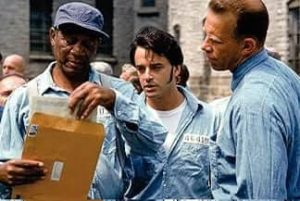The Shawshank Redemption (1994)

Review of The Shawshank Redemption (1994)
The Shawshank Redemption (1994), directed by Frank Darabont and based on Stephen King’s novella Rita Hayworth and Shawshank Redemption, is a masterpiece of modern cinema that has resonated with audiences since its release. Initially underappreciated at the box office, the film has since become one of the most beloved and influential movies of all time. With its deep themes of hope, friendship, and redemption, The Shawshank Redemption is a powerful, emotionally stirring journey through the human spirit.
Plot Summary: The story centers around Andy Dufresne (Tim Robbins), a banker who is wrongfully convicted of murdering his wife and her lover and sentenced to life in the notorious Shawshank State Penitentiary. Over the course of his decades in prison, Andy forms an unlikely friendship with Ellis “Red” Redding (Morgan Freeman), a seasoned inmate who acts as the prison’s unofficial “fixer.” While Andy initially struggles to adapt to prison life, he gradually uses his skills in accounting, his intelligence, and his calm demeanor to help the corrupt warden and the prison guards with their financial schemes. In the process, Andy finds a way to endure the harsh realities of prison life, while also nurturing a sense of hope that eventually leads to his extraordinary escape.
Themes and Atmosphere: At its heart, The Shawshank Redemption is a film about the transformative power of hope, and how the human spirit can endure even the harshest conditions. The prison setting becomes a metaphor for the oppressive nature of life itself, and Andy’s ability to find light in the darkest of places is one of the central messages of the film. The idea that “hope is a good thing, maybe the best of things, and no good thing ever dies” becomes the film’s emotional touchstone, guiding both Andy and Red through their emotional and physical struggles.
The film also touches on the themes of freedom and redemption, not just in the literal sense of Andy’s escape, but in the emotional freedom that he brings to those around him, particularly Red. In a world where so many prisoners are physically confined, the film suggests that it is the mental and emotional imprisonment that is most profound. Andy’s quiet defiance, his refusal to accept the hopelessness of his situation, serves as a beacon of strength for those around him, and ultimately, it is this resilience that leads to his redemption.
The relationship between Andy and Red is central to the emotional core of the film. Their evolving friendship, built on mutual respect, shared experience, and deep understanding, forms a profound bond that helps both men transcend their circumstances. This friendship provides the emotional heart of the movie and anchors the larger themes of hope, trust, and freedom.
Performance: The performances in The Shawshank Redemption are exceptional, with Tim Robbins and Morgan Freeman delivering career-defining roles. Robbins, as Andy Dufresne, is quietly powerful, bringing a sense of calm intelligence and dignity to his character. His portrayal of a man who refuses to give in to despair, despite the overwhelming circumstances, is both inspiring and deeply moving. Andy’s transformation over the years, from a shell-shocked newcomer to a self-assured, liberated man, is a testament to Robbins’ subtle but compelling performance.
Morgan Freeman, as Red, delivers one of the most iconic performances of his career. His deep voice and wise, measured delivery serve as the perfect counterpoint to Andy’s quiet determination. Freeman’s portrayal of Red is that of a man who has lost his belief in the possibility of change, only to have his faith restored through his friendship with Andy. Freeman’s chemistry with Robbins is palpable, and their scenes together are the emotional backbone of the film. The film’s narrator, Red provides the audience with a rich emotional perspective, and Freeman’s gravitas elevates the material.
The supporting cast, including Bob Gunton as the corrupt Warden Samuel Norton, William Sadler as the kind-hearted inmate Heywood, and Clancy Brown as the brutal Captain Byron Hadley, all deliver strong performances that help create a vivid, immersive world within Shawshank Prison.
Direction and Cinematography: Frank Darabont’s direction is masterful, skillfully balancing the emotional weight of the story with moments of quiet humor and levity. His pacing is deliberate, allowing the audience to become deeply invested in the lives of Andy and Red, and he carefully builds the film’s emotional resonance as it unfolds. The film’s tone ranges from bleak and oppressive to hopeful and triumphant, but Darabont never loses sight of the central theme of the power of hope. His direction allows the characters and themes to breathe, and he ensures that each moment of the film contributes to its overarching narrative.
Roger Deakins, one of the greatest cinematographers in modern cinema, brings his visual expertise to The Shawshank Redemption. The film’s cinematography, while grounded in realism, often employs striking imagery that enhances its emotional themes. The dark, oppressive interiors of Shawshank contrast with the expansive beauty of the outside world, symbolizing Andy’s long years of confinement and his eventual release. The famous shot of Andy standing in the rain after his escape is a perfect example of how Deakins uses light and shadow to emphasize the film’s emotional and thematic moments.
Soundtrack: The score by Thomas Newman is one of the film’s key emotional components, with its gentle piano-driven themes underscoring the narrative’s more reflective moments. The music complements the film’s tone, heightening the emotional impact of both the quieter, more intimate scenes and the film’s more triumphant moments. Newman’s score, like the rest of the film, strikes a balance between melancholy and hope, adding depth to the overall storytelling experience.
Conclusion: The Shawshank Redemption is a cinematic triumph that transcends the prison genre, exploring universal themes of hope, freedom, and friendship. The performances from Tim Robbins and Morgan Freeman are nothing short of legendary, and Frank Darabont’s direction elevates Stephen King’s novella to a profound level of emotional depth. The film’s emotional arc—from despair to redemption—is deeply resonant, and its message of the enduring power of hope remains powerful and relevant, even decades after its release.
It is rare for a film to be so universally beloved, but The Shawshank Redemption is one such rare gem. It is a story of survival, of finding light in the darkest of places, and of the human capacity for hope, resilience, and transformation. With its memorable performances, emotional depth, and timeless themes, The Shawshank Redemption is a film that continues to inspire and move audiences around the world











